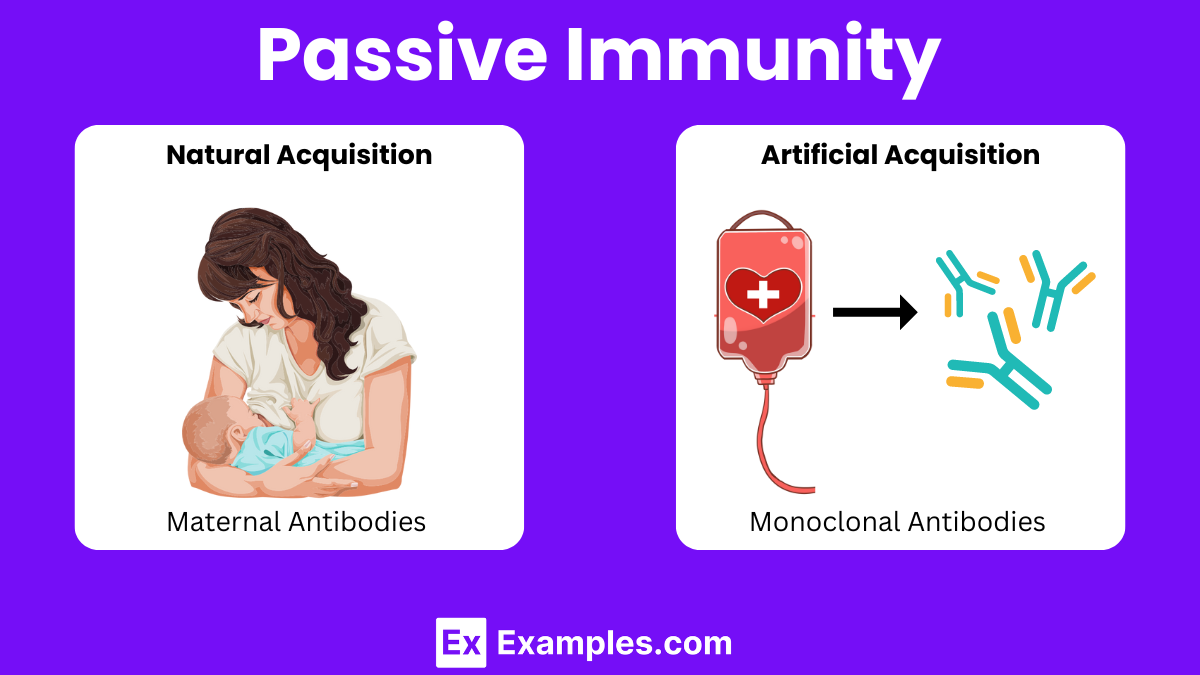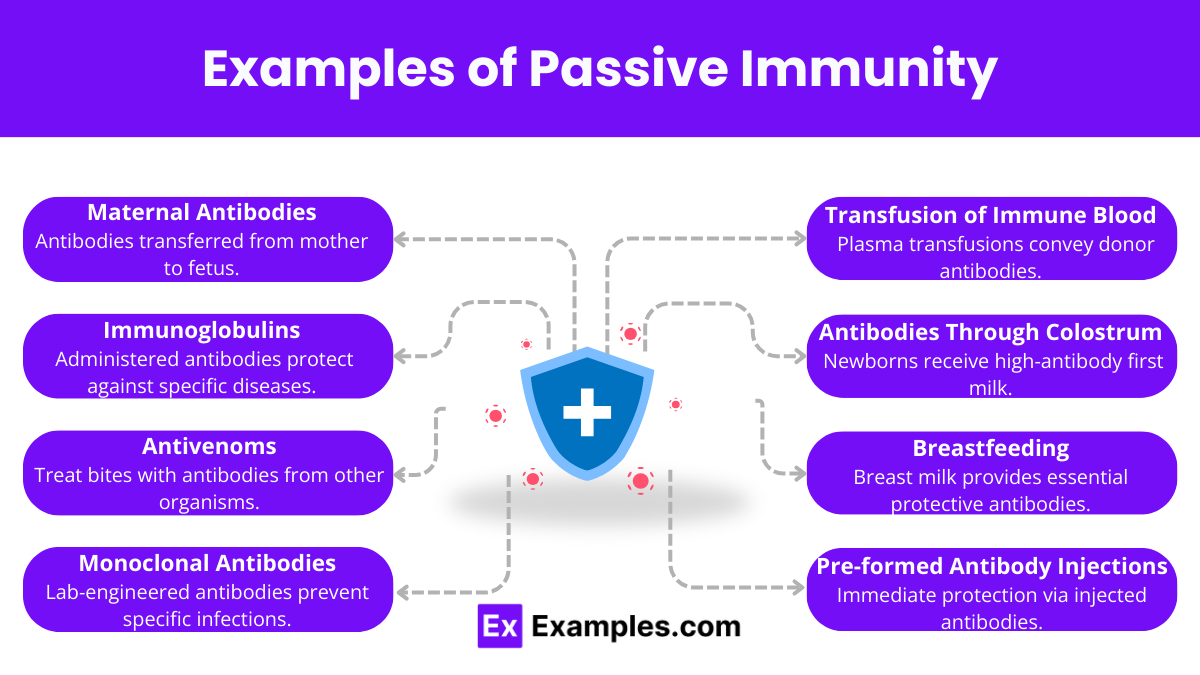What is passive immunity?
Immunity gained through vaccination
Immunity developed after exposure to an infection
Immunity obtained by receiving antibodies from another source
Immunity developed after the body's immune system responds to a pathogen


Passive immunity occurs when a person receives antibodies from another source, rather than producing them through their own immune system. This type of immunity provides immediate protection against specific infections but is temporary, typically lasting only a few weeks to months. Passive immunity is often used in cases where there is an immediate risk of disease and insufficient time for the body to develop its own immune response, such as with newborns receiving maternal antibodies or people receiving antivenom after a snakebite.
Passive immunity occurs when an individual is given antibodies from another source, rather than generating them internally through their own immune system. This form of immunity provides immediate protection against specific diseases but is temporary, lasting only a few weeks or months.
Passive immunity can be acquired in several ways
Passive immunity is when a person gets temporary protection from diseases by receiving antibodies from another source, rather than making them through their own immune system. This kind of immunity is especially important in protecting against diseases in situations where someone’s immune system isn’t strong or fully developed. Here are the main functions and characteristics of passive immunity:
Passive immunity offers instant protection against diseases. Unlike active immunity, which takes time to develop after being exposed to a disease, passive immunity starts working right away. This is because the antibodies are already prepared and active when they enter the body.
Although passive immunity acts immediately, it doesn’t last long. The borrowed antibodies are slowly broken down and removed from the body, usually in a few weeks to a few months. How long they last can vary based on where the antibodies came from.
Natural passive immunity gives immediate protection to infants against infections, which is vital in their early development. This immunity mainly comes from maternal antibodies. In the third trimester, antibodies and cells that fight pathogens move from the placenta to the fetus, providing crucial defenses before birth. After birth, infants get colostrum during the first nursing sessions, which is rich in antibodies and boosts their immune defense. Although breast milk has fewer protective components than colostrum, it still significantly helps the infant’s immunity. However, this protection is temporary, with maternal antibody levels dropping by about six months of age.
Artificial passive immunity involves giving antibodies to a person who hasn’t been exposed to a pathogen. These antibodies can come from the blood of people who have recovered from a disease or from vaccinated animals like horses, which were among the first sources for making antibody treatments. Today, this method is used to treat various infections, especially when an immediate immune response is needed in people with weak immunity.
Passive immunization started in the late 19th century with the work of Shibasaburo Kitasato and Emil von Behring. They first protected guinea pigs against diphtheria using heated blood from animals that had recovered from the disease. This was the first successful use of antibodies to treat a disease. Their work led to the creation of the diphtheria antitoxin, which soon became a standard treatment for human diphtheria. This method also laid the groundwork for using antibody-rich blood products to fight diseases like tetanus, smallpox, and bubonic plague. Research in the 20th century expanded these methods to prevent diseases like measles and infectious hepatitis, greatly impacting modern medicine.
Now, doctors use passive immunization as a treatment and as a way to prevent diseases in high-risk patients or those recently exposed to germs. They use antibodies to fight diseases like diphtheria, cytomegalovirus, hepatitis A, hepatitis B, rabies, and chickenpox. These treatments are crucial for people with weak immune systems or those who need immediate protection, providing essential defense until the body can develop its own immunity through natural exposure or vaccination.

Here are some primary examples that illustrate how passive immunity operates in various scenarios:
Passive immunotherapy involves administering pre-made antibodies to enhance the body’s defense against specific diseases.
Examples of active immunity include immunity developed from vaccinations or recovering from diseases like measles.
The most important source of passive immunity in pregnancy is the transfer of maternal antibodies to the fetus via the placenta.
Passive immunity provides immediate but temporary protection against infections by introducing external antibodies, crucial for immediate defense in vulnerable populations.
Text prompt
Add Tone
10 Examples of Public speaking
20 Examples of Gas lighting
What is passive immunity?
Immunity gained through vaccination
Immunity developed after exposure to an infection
Immunity obtained by receiving antibodies from another source
Immunity developed after the body's immune system responds to a pathogen
Which of the following is an example of passive immunity?
Vaccination for measles
Antibodies received from a tetanus antitoxin injection
Developing antibodies after recovering from the flu
Developing immunity after exposure to chickenpox
How long does passive immunity typically last?
Lifelong
Several years
A few months
It depends on the type of immunity
Which of the following is a source of natural passive immunity?
Blood transfusion
Antibodies in breast milk
Vaccination with a live attenuated virus
Production of antibodies by the immune system
Which of the following is an example of artificial passive immunity?
Receiving antibodies through breastfeeding
Immunoglobulin injections for rabies
Developing immunity after a viral infection
Getting a flu shot
In what situation would passive immunity be preferred over active immunity?
For long-term protection
When immediate protection is needed
To prevent future infections
To allow the body to naturally fight off infection
Which type of immunity involves the transfer of ready-made antibodies?
Active immunity
Natural immunity
Passive immunity
Cellular immunity
What distinguishes passive immunity from active immunity?
Passive immunity is longer-lasting than active immunity
Passive immunity involves the body producing its own antibodies
Passive immunity does not involve memory cells
Passive immunity is always naturally acquired
Which of the following is NOT a characteristic of passive immunity?
It provides immediate protection
It is short-lived
It stimulates the production of memory cells
It can be acquired naturally or artificially
Passive immunity is important in which of the following cases?
A patient needs long-term immunity against a virus
A newborn receives antibodies from the mother
A vaccine is given to develop immunity
The body produces antibodies after infection
Before you leave, take our quick quiz to enhance your learning!

